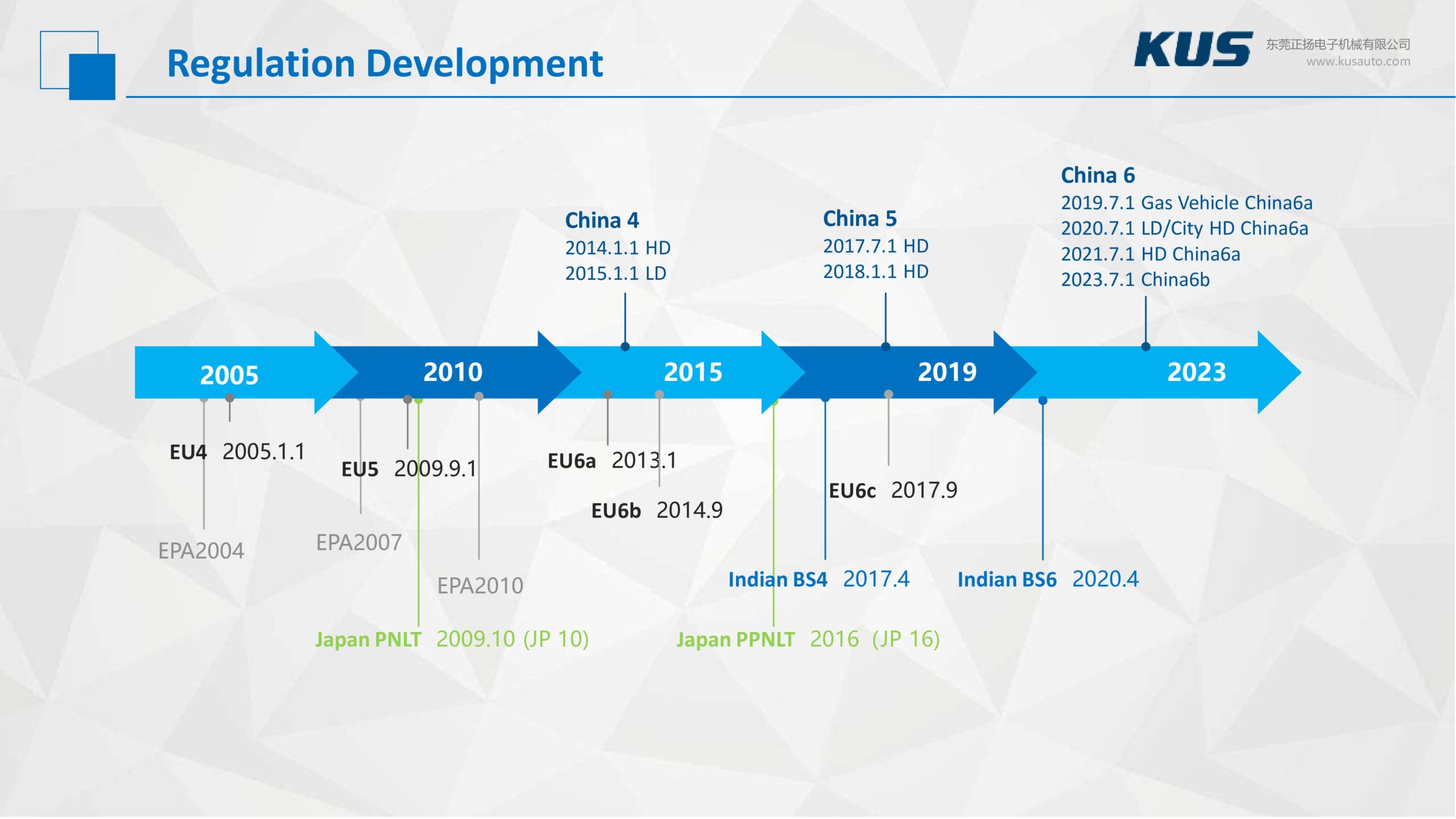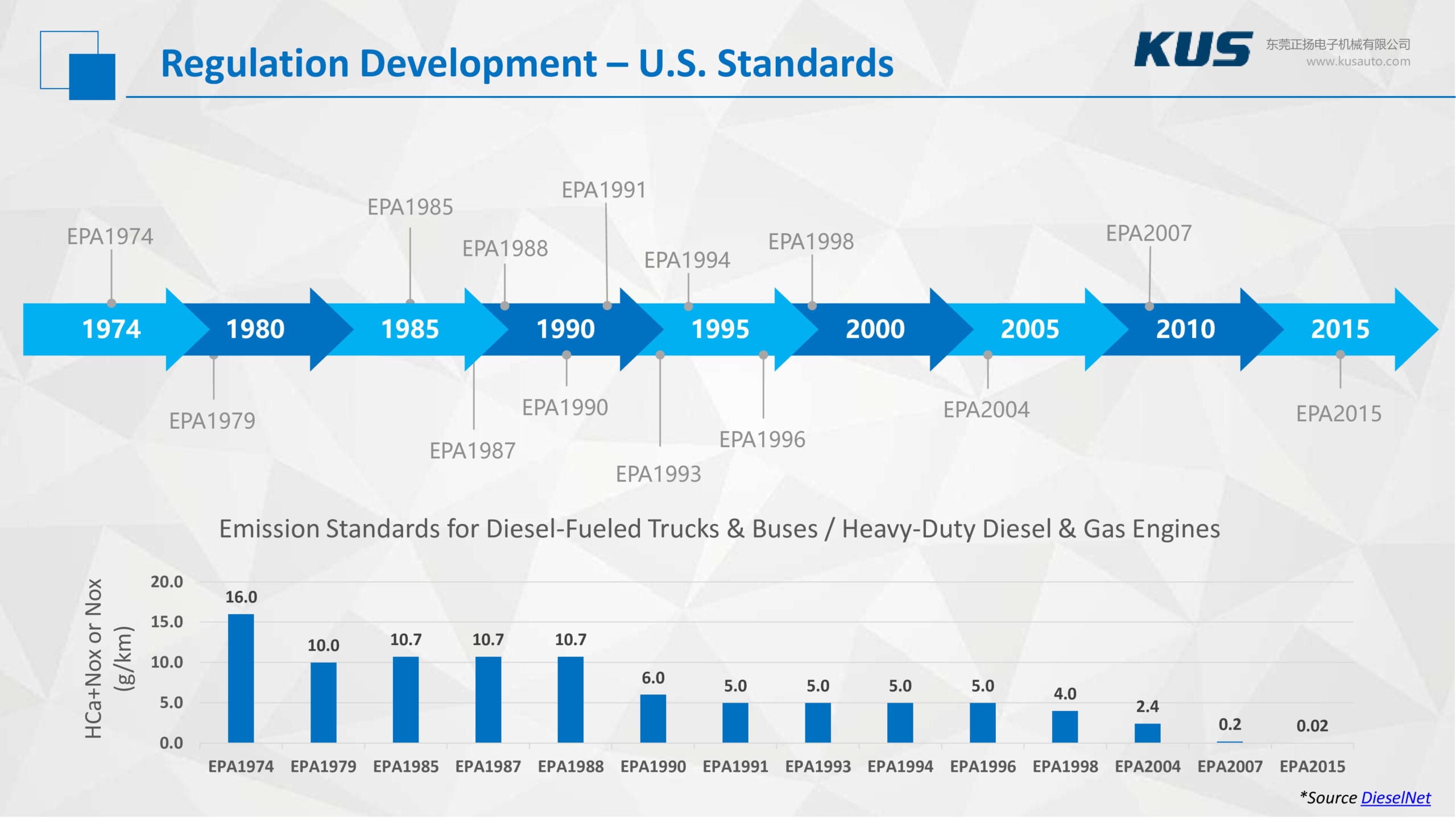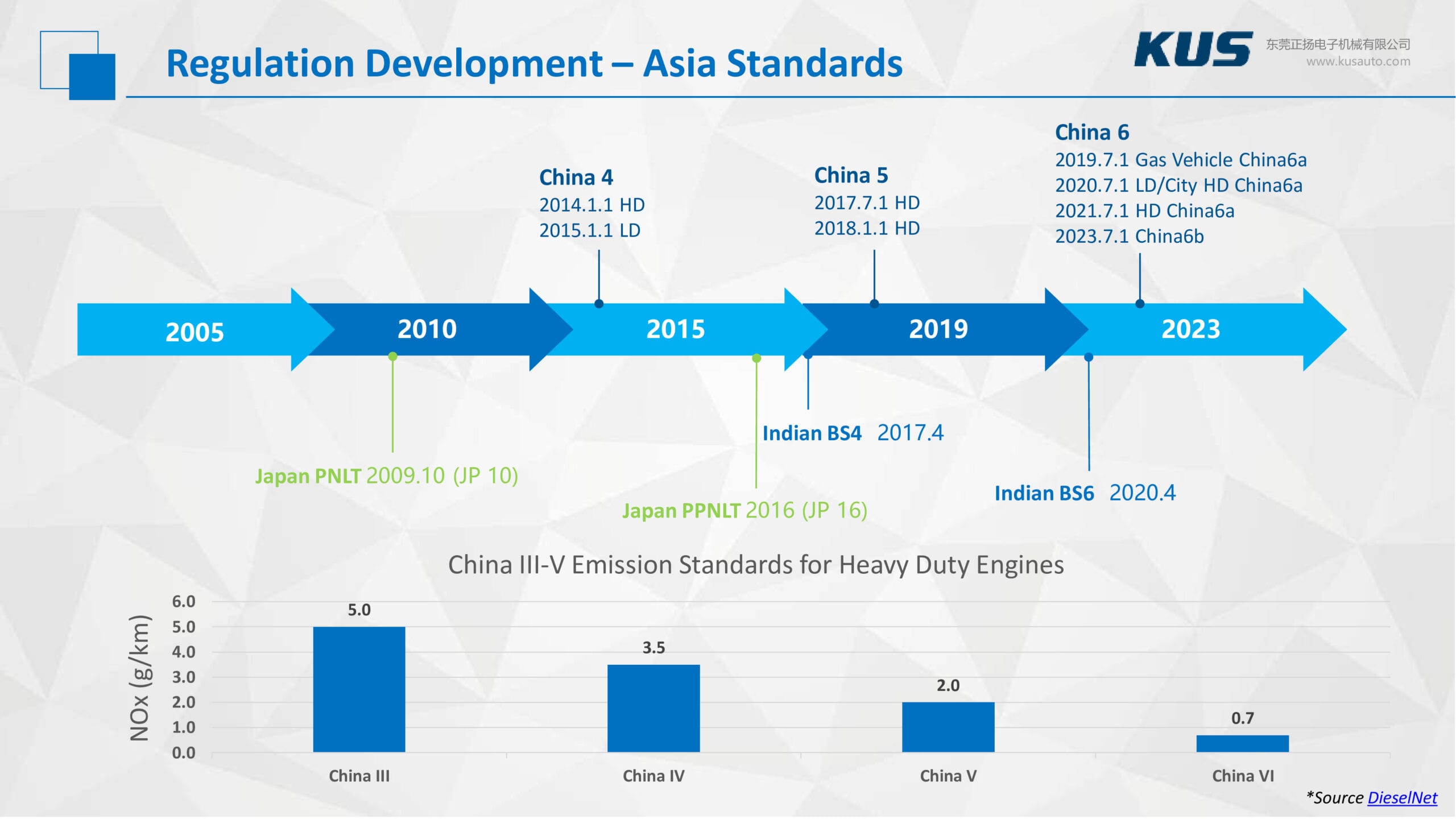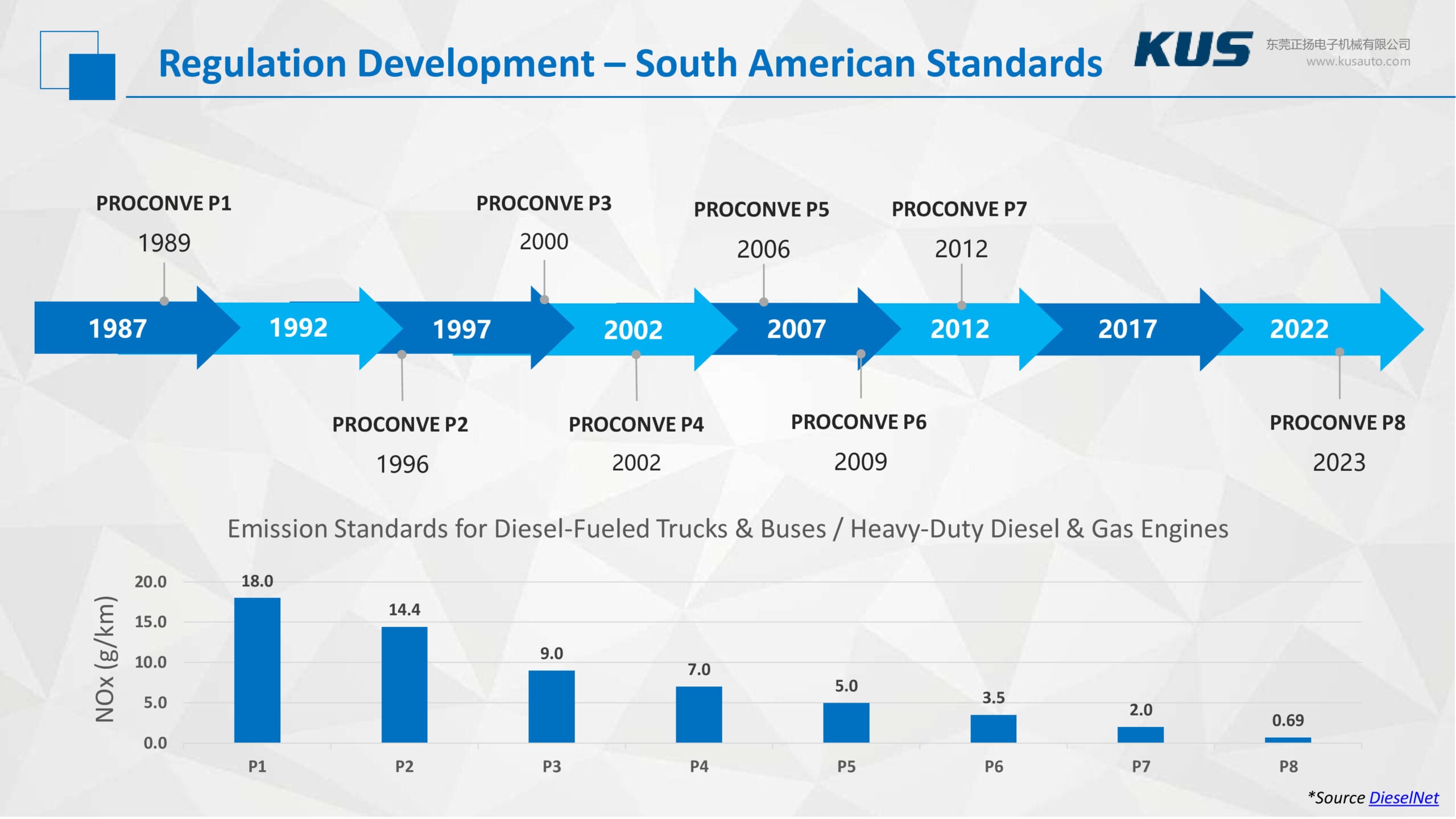
An understanding of emission regulations underlies any work that contributes to the manufacture of commercial and industrial vehicles. International standards call for highly effective exhaust after-treatment systems in order to mitigate impacts on air, water, and human health. These regulations are incredibly detailed, complex, and vary by country. Here, we take a look into the broad overview of global emission regulations.
Why Emissions are Subject to Regulation
Fueled vehicles are major sources of harmful pollutants, such as ground-level ozone and particulate matter (PM). Emissions reduction for diesel after-treatment systems focus on NOx, hydrocarbons, and PM. An additional goal is to improve fuel economy.
Components of Fuel Emissions
Of special concern for makers of diesel engines are nitric oxide and nitrogen dioxide. Nitric oxide or nitrogen monoxide, abbreviated NO, is a gas that forms when nitrogen is oxidized. At extremely cold temperatures, it liquifies and turns blue, but it’s most commonly present as a colorless toxic gas. When exposed to air, it reacts with oxygen to form nitrogen dioxide, abbreviated NO2. The two gases are collectively referred to as NOx.
A hydrocarbon is an organic compound consisting of only hydrogen and carbon atoms. They occur naturally in crude oils, like petroleum and natural gas. When exposed to sunlight or NOx, they undergo a chemical reaction. As a result, they build up in the Earth’s atmosphere, increasing the greenhouse effect and depleting the ozone.
Particulate matter refers to solid or liquids found in small enough particles to be inhaled. They can enter the lungs or bloodstream, causing health problems, and can also be seen in the atmosphere when they build up.
How Regulations Started
Emission regulations vary by country and can change frequently based on legislation, scientific findings, and market demands. Regulations were introduced in the United States, Japan, and Canada in 1973 and 1974, and in the European Economic Community in 1977. These standards have generally grown more stringent over time but have never been unified.
Cleaner burning fuel, in-cylinder combustion performance, thermal management, and aftertreatment systems are approaches to reduce emissions.
U.S. Diesel Emissions Regulations
In the United States, the Environmental Protection Agency is responsible for emission regulations. They categorize regulations by market: onroad, non-road, marine, and locomotive. The standards are designated, according to when they took effect and their stringency, starting with Tier 1 in 1994, and progressing through Tier 4. Tier 1 – 4 is used for off-road, industrial, and locomotive but isn’t used for on-road. Tier 4 is further segmented into interim and final. Tier 4 final standards reduce harmful emissions by 85 to 90 percent.
The EPA regulates commercial trucks and buses as onroad “heavy-duty” but also has regulations for medium and light duty commercial trucks. Most of the regulations are related to diesel engines. Regulations for nonroad compression-ignition (diesel) engines include construction equipment, farm tractors and other agricultural equipment, forklifts, airport ground service equipment, and utility equipment such as generators, pumps, and compressors. The Diesel Emissions Reduction Act (DERA) Program funds grants and rebates that protect human health and improve air quality by reducing harmful emissions from diesel engines.
California has stricter standards, directed by California Air Resource Board (CARB), than the rest of the country. Other states can choose to follow the CARB regulations or not, but a new vehicle or equipment cannot legally operate in California without meeting these standards. Therefore, engines are typically developed to meet those standards.
Canadian standards are comparable to U.S. standards and are maintained by Environment Canada. Since many vehicles travel back and forth between Canada and the U.S., it makes sense that they would need to meet the same standards.

European Standards
European emission standards for new heavy-duty diesel engines are commonly referred to as Euro I through Euro VI, which roughly correspond to the EPA’s Tiers. The latest round of standards, approved in 2016, is comparable in stringency to the U.S. Tier 4 final standards. It introduced particulate number limits and extended the scope of the regulation to engines below 19kW and greater than 560 kW. Australia follows European standards.

Asian Standards
Across Asia, emission regulations vary by country but Japan sets the standard. In Japan, the standards are developed by a group of government agencies: the Ministry of the Environment, the Ministry of Land, Infrastructure and Transport, and the Ministry of Economy, Trade and Industry. This group first introduced emission standards in the 1980s but made them much more strict in the early 2000s. For example, marine engines only became regulated in 2003. They also have a program of retrofitting older diesel engines with PM control devices.
Japanese standards apply to specific categories of in-use highway vehicles including cargo vehicles such as trucks and vans, buses, and special purpose motor vehicles, irrespective of fuel type. Other counties may base their standards on European or Japanese examples.

South American Standards
Brazil, Chile, Argentina, and Peru each have their own standards for heavy duty vehicles. These are typically based on U.S. or European standards, or a combination. Brazil being the largest market and the main manufacturer in the South American market, leads the region in regulation standards.

How Engine Manufacturers Reduce Harmful Emissions
To comply with emission regulations, engine manufacturers rely on certain technologies. These include:
- DPF (Diesel Particulate Filter) to reduce particulate matter
- EGR (Exhaust Gas Circulation) to reduce nitrogen oxide (NOx) by recirculating some of the engine’s exhaust gas back into the engine cylinders, instead of into the atmosphere
- SCR (Selective Catalytic Reduction) to convert NOx to nitrogen, water, and CO2
For our purposes, we will focus on SCR. SCR is an exhaust after-treatment system, which consists of several components:
- NOx sensor
- Diesel Particulate Filter
- Diesel Oxidation Catalyst
- DEF Tank, DEF Level Sensor, Quality Sensor
- DEF pump/supply module
- Catalyst Chamber
This system reduces emissions pollutants, including NOx from the engine exhaust gas. Diesel Exhaust Fluid (DEF) is injected from a separate tank into the SCR system to convert NOx into harmless H2O and N2. When the water evaporates from engine heat, the urea thermally decomposes, resulting in the harmless byproducts.
DEF consists of 32.5 percent urea, or aqueous ammonia solution, and 67.5 percent deionized water. AdBlue is a brand name for DEF, trademarked by Germany’s Association of the Automotive Industry. It may also be referred to as AUS 32. It is used in diesel passenger cars as well as commercial and non-road vehicles.
KUS Exhaust Aftertreatment
Since 2003, KUS has been working with global exhaust after-treatment system integrators, vehicle and engine OEMs to design and manufacture components for the SCR system. We manufacture DEF level sensors, DEF tank assembly solutions, and DEF quality sensors in accordance with ISO 22241 standards to meet emission laws and regulations.
We appreciate the importance of reliability, accuracy, and durability. Let us work with you to find the most appropriate SCR solutions for your application.
